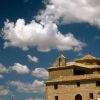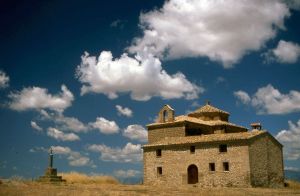This chapel is located on the path that connects the A-1225 road with Laperdiguera.
The San Roman shrine has been closely linked to the livestock track since its origins due to its location close to the migratory route that links Broto in the Pyrenees with Mequinenza in the south. Large flocks of animals have traditionally crossed the Somontano territory; on their way to the Pyrenean pastures to spend the summer months and back down to the southern plains in search of gentler winters. The shrine was a much frequented stopping place for shepherds travelling this route, many of whom would spend the night in the house attached to the chapel, which took on the role of an inn. There was also a livestock holding pen to the side of the building for the migrating animals.
Until recently, the chapel was used for exorcisms. It is said that the possessed would spend various days tied to a bed in the inn, wracked with screams, until the devil left their body. It is currently used for the celebration of occasional but well-attended pilgrimages.
The large 18th century building was built in the Baroque style from masonry reinforced with ashlars at each corner. The Latin cross layout incorporates a single nave divided into three sections; the section at the west end houses a choir perched on a flat slab floor and the middle section is covered by a barrel vault with lunettes, which opens up into two side chapels. The third section boasts a large dome supported by pendentives, the windows of which are currently blocked. This part of the nave has large semi-circular arches that lead into two side chapels, which, together with the vestry, provide a sensation of harmony and balance.
The vestry is covered with a barrel vault with lunettes and is decorated with vividly coloured paintings that represent the exaltation of Christ (IHS), the Virgin Mary and San Ramon. The remains of mural paintings can be seen in other parts of the church.




